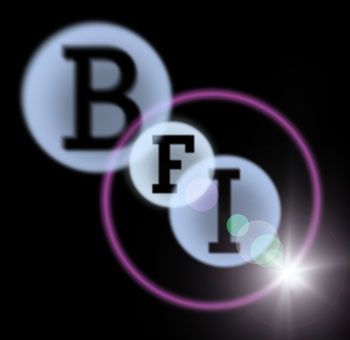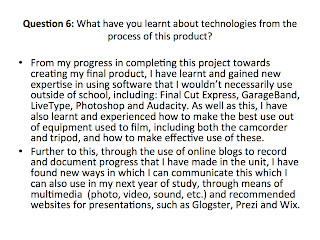After watching our opening sequence for what we thought was the last time as a group in the role of the audience, we decided that there were various areas in which we thought that we could improve our final product so that we could say that we were proud of what we had created. Collectively, we agreed that what we had initially composed for our accompanying soundtrack to our opening sequence wasn't very well suited to what we originally had in mind for our film and that it wasn't necessary something that the audience would be expecting to hear whilst watching our work. Generally, the original piece of music that we had included within our opening sequence was rather annoying to listen to throughout, which made viewing our final product especially annoying as the track featured many different sounds, many of which had no relevance to each other, let alone the film and were, with respect, placed onto the timeline on GarageBand with no particular thought or reason behind the decision.
We didn't want to waste any time modifying our first edition of our soundtrack as we thought that it wouldn't be a very effective use of our time in which we had to complete it, so we decided that it would be best to start again from scratch. This would enable us to capture exactly what we originally had in mind for our film and would also provide us with the perfect platform to create something that we felt would demonstrate our skills in the area in question. In most cases, during the opening sequences of a film, the track doesn't change or vary to much throughout and retains the attention of the audience and therefore begins to create tension as to what may be about to happen. We thought that it would be best to achieve this effect by limiting ourselves to only a certain amount of sound clips in order to avoid the previous mistake that we had made. Further to this, as listening to the same recordings for a couple of minutes start to become a little bit tedious, different clips which were not previously used were included within the music to help to provoke suspense within the audience.
Whilst we were reviewing what we had composed for our final piece of music for our opening sequence, we noticed that there was a long period where a black screen was present in our product where the voiceover from the actor was taking place and this was something that we were not keen on at all as a group. As this would not usually be common in an opening sequence to a film, we looked back on what we had earlier analysed and research throughout the course and came to the conclusion that we could fill this space but introducing additional titles into the video that we were missing.
By amending and making these changes to our final opening sequence, I felt that this made our film more of a professional product and complete as a whole as it no longer featured any errors that we previously hadn't noticed and would've got marked down for and any annoying or irritating elements.
Tom's Media Studies Blog
Tuesday 8 January 2013
Tuesday 20 March 2012
Evaluation
Question 1: In what ways does your media product use, develop or challenge forms and conventions of real media products?
a. Genre, b. Narrative structure, c. Form, d. Style.
Question 2: How does your media product represent particular social groups?
Question 3: What kind of media institution might distribute your media product and why?
Question 4: Who would be the audience for your media product?
Question 5: How did you attract/address your audience?
Question 6: What have you learnt about technologies from the process of this product?
Question 7: Looking back at your preliminary task, what do you feel you have learnt in the progression from it to the full product?
a. Genre, b. Narrative structure, c. Form, d. Style.
Question 2: How does your media product represent particular social groups?
Question 3: What kind of media institution might distribute your media product and why?
Question 4: Who would be the audience for your media product?
Question 5: How did you attract/address your audience?
Wednesday 14 March 2012
Final Opening Sequence
The video embedded below is our final opening sequence, a starting to a film entitled 'Chroniker'. We hope that you appreciate our work and enjoy watching our product, which can also be viewed at: http://www.youtube.com/watch?v=1G_YxaM0_7Q.
Friday 24 February 2012
Feedback from Audience
We held a film showcase in class in order to be able to receive feedback from our peers on how our opening sequence could be improved. The constructive criticism we gained enabled us to improve our film and the comments gathered were as follows:
We made use of the responses collected from our peer assessments and we decided to make the following amendments to our product:
By organising and participating in the class opening sequence showcase, we were presented with the opportunity to be able to recognise and rectify any errors, flaws or problems, as well as earn praise, related to our product. Overall, we found this exercise beneficial to our progress and success in creating our somewhat respectable final opening sequence.
I have uploaded scanned copies of the film feedback forms completed during the carousel by my peers (click to enlarge):
- Our storyline was unclear, confusing and hard to follow.
- Our opening sequence lacked and needed to have credits and titles, a soundtrack and voiceover added.
We made use of the responses collected from our peer assessments and we decided to make the following amendments to our product:
- We removed some of the shots from our opening sequence as we felt that they confused and lengthened our storyline.
- We ensured that we created credits and titles for our film, as well as including a soundtrack and voiceover.
By organising and participating in the class opening sequence showcase, we were presented with the opportunity to be able to recognise and rectify any errors, flaws or problems, as well as earn praise, related to our product. Overall, we found this exercise beneficial to our progress and success in creating our somewhat respectable final opening sequence.
I have uploaded scanned copies of the film feedback forms completed during the carousel by my peers (click to enlarge):
Friday 10 February 2012
Planning & Meetings: Week #6, February 6th - 10th
Without the encouragement from peers and staff alike and the dedication of my fellow group members, I don't think we would have been able to submit our final opening sequence on time, which was not only a hugely frustrating experience, but an extremely rewarding process too!
Friday 3 February 2012
Planning & Meetings: Week #5, January 30th - February 3rd
 In this week, we began to move to the more advanced stages of editing, namely continuity and special effects, utilising the tools available to us on the software that we were using, Apple's Final Cut Express (logo shown to the right).
In this week, we began to move to the more advanced stages of editing, namely continuity and special effects, utilising the tools available to us on the software that we were using, Apple's Final Cut Express (logo shown to the right).We were shown an extract, the opening sequence from a French film, titled 'Mesrine: Killer Instinct'. In the sequence, the creators of the movie utilised a technique called 'spilt screen' and we grew our inspiration for our film from this. Here, I have analysed the opening title sequence of the previously mentioned film, whilst the video of it can also be viewed below:
Mesrine: Killer Instinct (2008)
Tuesday 31 January 2012
Research into Institutions, Film and Production Companies
 The British Film Institute (BFI) is a charitable organisation established by Royal Charter to: encourage the development of the arts of film, television and the moving image throughout the United Kingdom, to promote their use as a record of contemporary life and manners, to promote education about film, television and the moving image generally, and their impact on society, to promote access to and appreciation of the widest possible range of British and world cinema and to establish, care for and develop collections reflecting the moving image history and heritage of the UK.
The British Film Institute (BFI) is a charitable organisation established by Royal Charter to: encourage the development of the arts of film, television and the moving image throughout the United Kingdom, to promote their use as a record of contemporary life and manners, to promote education about film, television and the moving image generally, and their impact on society, to promote access to and appreciation of the widest possible range of British and world cinema and to establish, care for and develop collections reflecting the moving image history and heritage of the UK. A production company provides the physical basis for works in the realms of the performing arts, new media art, film, television, radio and video.
A production company provides the physical basis for works in the realms of the performing arts, new media art, film, television, radio and video.Production companies may be directly responsible for fundraising for the production or may accomplish this through a parent company, partner or private investor. They handle: budgeting,
 scheduling, scripting, the supply with talent and sources, the organisation of stuff, the production itself, post-production, distribution and marketing. Production companies are often
scheduling, scripting, the supply with talent and sources, the organisation of stuff, the production itself, post-production, distribution and marketing. Production companies are often either owned or under contract with a media conglomerate, film studio or entertainment company, who act as the production company's parent company, together, this has become known as the 'studio system'. They can also be mainstream independent or completely independent. Production companies can also work together in co-productions.
 Some of the major and notable film production companies include:
Some of the major and notable film production companies include:- DreamWorks Pictures & Animation.
- 20th Century Fox.
- Universal Studios.
- Paramount Pictures.
- Columbia Pictures.
- Warner Bros. Pictures.
- Walt Disney Pictures.
- Lions Gate Entertainment.
Subscribe to:
Posts (Atom)











